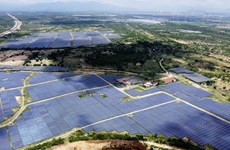Vietnam’s transportation costs among region's highest
Small-scale operations, improper infrastructure and a lack of
co-operation among transport enterprises has inflated Vietnam's
transportation costs above that of neighbouring countries, according to a
seminar held on March 28.
Small-scale operations, improper infrastructure and a lack of
co-operation among transport enterprises has inflated Vietnam's
transportation costs above that of neighbouring countries, according to a
seminar held on March 28.
Speaking at the seminar titled "Transportation costs in Vietnam " held by the Transport Ministry, deputy minister Le Dinh Tho said transport costs in the country were the highest in Southeast Asia , but few studies had been conducted to clarify the state of the status quo.
Typically, transportation costs account for less than 10 percent of gross domestic production in developed countries, with the percentage in developing countries around 14-15 percent.
He said that lower transportation costs were vital for the country's development and competitiveness, especially given the increasingly tough regional and global environment.
Nguyen Xuan Thuy, deputy head of Transportation Department under the Vietnam Road Administration, said the country had around 11,000 transport enterprises, including 8,000 freight enterprises and 3,000 passenger-vehicle companies.
However, most of the enterprises were operating on a small-scale with less than 10 vehicles, he said.
"The small enterprises usually don't have a business network or channel to contact clients, which resulted in inefficient operations," he said.
For example, according to the Transport Development and Strategy Institute, around 70 percent of trucks carried goods one way and were empty on return journeys. This increased the cost of transporting goods on the roads by 30 percent.
The costs were also pushed up because providers were using old coaches or trucks that were not fuel efficient and required a frequent maintenance – which raised the risk of traffic accidents, he said.
Moreover, the need to develop a depot system to gather and distribute goods on long-distance routes had fallen by the wayside, he said, explaining that ferrying huge amounts of small trucks on long routes would be more costly. Small, scattered depots required more time to collect, load and unload goods, he said.
According to the Vietnam Automobile Transportation Association, in the last 15 years, the price of passenger transportation had risen sevenfold in Vietnam, not accounting for inflated prices during peak holiday periods.
The higher prices were blamed on the increasing cost of operating cars, buying fuel, employing labour and paying road fees.
According to a World Bank report, logistical costs in Vietnam were estimated to account for around 20 percent of the GDP. By contrast, the proportion in the US was 9.2 percent, while being 12 percent in Europe and 13.5 percent in Mexico . The global average is around 13.8 percent.
The report shows that logistics operations in Vietnam are relatively high when compared with regional peers like China , Malaysia , and Thailand . It is estimated that Vietnam 's shippers spend approximately 100 million USD annually on extra inventory carrying costs incurred due to import-export clearance delays. This amount is projected to reach 180 million USD by 2020. Several factors were found to be fuelling high costs, including cumbersome and inconsistently applied government regulations and major supply-demand imbalances in infrastructure provision.
These drawbacks can be reverted if the country adopts a number of actions, such as minimising paper-based processes in the customs and technical clearance of imports and exports, the report said. It also advocated for Vietnam to create "multimodal logistics corridors" where containerised flows on trucks or barges would be able to move on adequate infrastructure and with minimal regulatory delays.
Opening the logistics market and promoting a more sustainable supply-demand balance in the trucking industry would also help.-VNA
Speaking at the seminar titled "Transportation costs in Vietnam " held by the Transport Ministry, deputy minister Le Dinh Tho said transport costs in the country were the highest in Southeast Asia , but few studies had been conducted to clarify the state of the status quo.
Typically, transportation costs account for less than 10 percent of gross domestic production in developed countries, with the percentage in developing countries around 14-15 percent.
He said that lower transportation costs were vital for the country's development and competitiveness, especially given the increasingly tough regional and global environment.
Nguyen Xuan Thuy, deputy head of Transportation Department under the Vietnam Road Administration, said the country had around 11,000 transport enterprises, including 8,000 freight enterprises and 3,000 passenger-vehicle companies.
However, most of the enterprises were operating on a small-scale with less than 10 vehicles, he said.
"The small enterprises usually don't have a business network or channel to contact clients, which resulted in inefficient operations," he said.
For example, according to the Transport Development and Strategy Institute, around 70 percent of trucks carried goods one way and were empty on return journeys. This increased the cost of transporting goods on the roads by 30 percent.
The costs were also pushed up because providers were using old coaches or trucks that were not fuel efficient and required a frequent maintenance – which raised the risk of traffic accidents, he said.
Moreover, the need to develop a depot system to gather and distribute goods on long-distance routes had fallen by the wayside, he said, explaining that ferrying huge amounts of small trucks on long routes would be more costly. Small, scattered depots required more time to collect, load and unload goods, he said.
According to the Vietnam Automobile Transportation Association, in the last 15 years, the price of passenger transportation had risen sevenfold in Vietnam, not accounting for inflated prices during peak holiday periods.
The higher prices were blamed on the increasing cost of operating cars, buying fuel, employing labour and paying road fees.
According to a World Bank report, logistical costs in Vietnam were estimated to account for around 20 percent of the GDP. By contrast, the proportion in the US was 9.2 percent, while being 12 percent in Europe and 13.5 percent in Mexico . The global average is around 13.8 percent.
The report shows that logistics operations in Vietnam are relatively high when compared with regional peers like China , Malaysia , and Thailand . It is estimated that Vietnam 's shippers spend approximately 100 million USD annually on extra inventory carrying costs incurred due to import-export clearance delays. This amount is projected to reach 180 million USD by 2020. Several factors were found to be fuelling high costs, including cumbersome and inconsistently applied government regulations and major supply-demand imbalances in infrastructure provision.
These drawbacks can be reverted if the country adopts a number of actions, such as minimising paper-based processes in the customs and technical clearance of imports and exports, the report said. It also advocated for Vietnam to create "multimodal logistics corridors" where containerised flows on trucks or barges would be able to move on adequate infrastructure and with minimal regulatory delays.
Opening the logistics market and promoting a more sustainable supply-demand balance in the trucking industry would also help.-VNA













